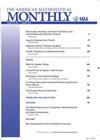a2=b2+cd,勾股公式的一个推广
IF 0.4
4区 数学
Q4 MATHEMATICS
引用次数: 0
摘要
亨利·佩里格尔是一位业余数学家,1868年至1897年为伦敦数学学会会员。他最出名的可能是通过解剖和换位来证明勾股定理[3,4]。在这里,我们扩展了Perigal方法,为一个被称为扩展毕达哥拉斯公式[1,2]的结果给出了一个新的证明。考虑三角形ABC,其中BC≥AB。设D为AC上的点,使得BD=AB,E为BA的扩展上的点(其中AE=DC)。三角形EAA′和CDB是全等的,EA′=CB,A EA′=D CB。本文章由计算机程序翻译,如有差异,请以英文原文为准。
a2=b2+cd, an Extended Pythagorean Formula
Henry Perigal was an amateur mathematician and a member of the London Mathematical Society from 1868 to 1897. He is perhaps best known for his proof of the Pythagorean theorem by dissection and transposition [3, 4]. Here we extend the Perigal method to give a new proof for a result that has been called the extended Pythagorean formula [1, 2]. Consider triangle ABC, with BC ≥ AB. Let D be the point on AC such that BD = AB and E the point on the extension of BA where AE = DC. The triangles EAA′ and CDB are congruent, EA′ = CB, and A EA′ = D CB.
求助全文
通过发布文献求助,成功后即可免费获取论文全文。
去求助
来源期刊

American Mathematical Monthly
Mathematics-General Mathematics
CiteScore
0.80
自引率
20.00%
发文量
127
审稿时长
6-12 weeks
期刊介绍:
The Monthly''s readers expect a high standard of exposition; they look for articles that inform, stimulate, challenge, enlighten, and even entertain. Monthly articles are meant to be read, enjoyed, and discussed, rather than just archived. Articles may be expositions of old or new results, historical or biographical essays, speculations or definitive treatments, broad developments, or explorations of a single application. Novelty and generality are far less important than clarity of exposition and broad appeal. Appropriate figures, diagrams, and photographs are encouraged.
Notes are short, sharply focused, and possibly informal. They are often gems that provide a new proof of an old theorem, a novel presentation of a familiar theme, or a lively discussion of a single issue.
Abstracts for articles or notes should entice the prospective reader into exploring the subject of the paper and should make it clear to the reader why this paper is interesting and important. The abstract should highlight the concepts of the paper rather than summarize the mechanics. The abstract is the first impression of the paper, not a technical summary of the paper. Excessive use of notation is discouraged as it can limit the interest of the broad readership of the MAA, and can limit search-ability of the article.
 求助内容:
求助内容: 应助结果提醒方式:
应助结果提醒方式:


